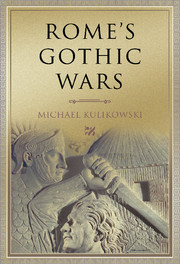Book contents
- Frontmatter
- Dedication
- Contents
- MAPS
- ACKNOWLEDGEMENTS
- Prologue BEFORE THE GATES OF ROME
- 1 THE GOTHS BEFORE CONSTANTINE
- 2 THE ROMAN EMPIRE AND BARBARIAN SOCIETY
- 3 THE SEARCH FOR GOTHIC ORIGINS
- 4 IMPERIAL POLITICS AND THE RISE OF GOTHIC POWER
- 5 GOTHS AND ROMANS, 332–376
- 6 THE BATTLE OF ADRIANOPLE
- 7 THEODOSIUS AND THE GOTHS
- 8 ALARIC AND THE SACK OF ROME
- Epilogue THE AFTERMATH OF ALARIC
- GLOSSARY OF ANCIENT SOURCES
- BIOGRAPHICAL GLOSSARY
- FURTHER READING
- NOTES
- INDEX
6 - THE BATTLE OF ADRIANOPLE
Published online by Cambridge University Press: 05 August 2015
- Frontmatter
- Dedication
- Contents
- MAPS
- ACKNOWLEDGEMENTS
- Prologue BEFORE THE GATES OF ROME
- 1 THE GOTHS BEFORE CONSTANTINE
- 2 THE ROMAN EMPIRE AND BARBARIAN SOCIETY
- 3 THE SEARCH FOR GOTHIC ORIGINS
- 4 IMPERIAL POLITICS AND THE RISE OF GOTHIC POWER
- 5 GOTHS AND ROMANS, 332–376
- 6 THE BATTLE OF ADRIANOPLE
- 7 THEODOSIUS AND THE GOTHS
- 8 ALARIC AND THE SACK OF ROME
- Epilogue THE AFTERMATH OF ALARIC
- GLOSSARY OF ANCIENT SOURCES
- BIOGRAPHICAL GLOSSARY
- FURTHER READING
- NOTES
- INDEX
Summary
THE BATTLE OF ADRIANOPLE WIPED OUT TWO-THIRDS OF THE whole field army of the Roman East. It was the worst military disaster of the Roman imperial era, and one of the worst in Roman history. That it was inflicted by barbarians made it instantly controversial, as contemporaries struggled to understand the reasons for the loss. For them, little save divine displeasure could explain such a calamity, so debate centred on which god was angry and why. But from the perspective of the modern historian, the trail of events that led to Adrianople is dotted with human error at every step. The Goths who defeated the emperor Valens at Adrianople in 378 were not a horde of unstoppable invaders. They were, for the most part, the same Goths who had crossed the Danube just two years earlier, in 376, having done so with the full approval of the imperial government. The reception of barbarians into the empire was no unprecedented novelty, but a well-known procedure with centuries of success behind it. Of course, accidents can happen whenever large numbers of people move from one place to another. But the path to Adrianople was no accident. The orderly reception of the Goths broke down through mismanagement and thereafter the imperial government repeatedly exacerbated the problem in a toxic combination of venality and incompetence. And so the crisis marched inexorably onwards to the fatal 9th of August 378.
A modern narrative history is entirely at the mercy of the ancient sources that happen to survive, which condition both its depth and its detail. For the two years before Adrianople, our access to one particular stream of Gothic history grows tremendously larger. The Goths who entered the empire in 376 are better known to us than are any of their predecessors, or indeed any of their contemporaries who remained outside the empire.
- Type
- Chapter
- Information
- Rome's Gothic WarsFrom the Third Century to Alaric, pp. 123 - 143Publisher: Cambridge University PressPrint publication year: 2006

